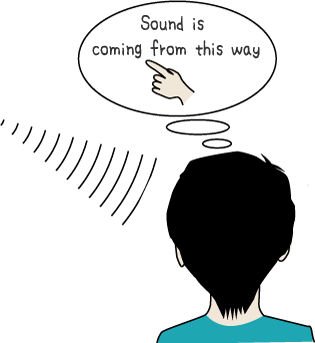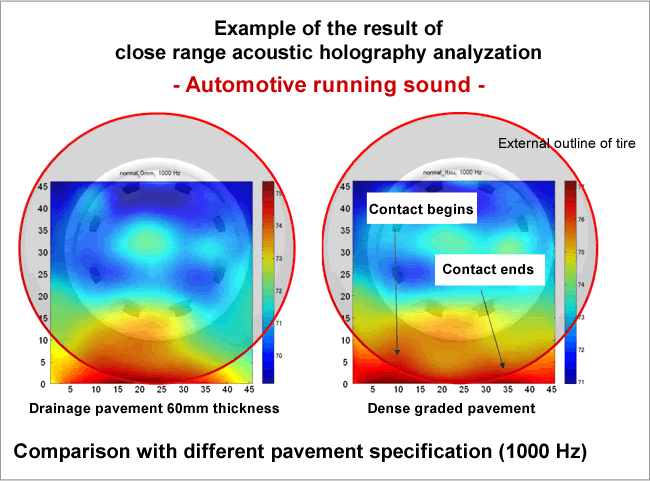- HOME
- Ono Sokki's Patio
- Sound direction

Sound direction
Ken: There was an evacuation drill at school yesterday. When we were at the gym, the PA system turned on and our teacher told us to evacuate toward the direction of the sound. We didn’t understand since it was everybody’s first time, but in the end, students parted from the middle of the gym and evacuated in two ways to the nearest exit. Maybe the drill was a success.
Dad: I heard your school installed an evacuation guidance system using the precedence effect, so it was a drill for that.
Ken: Precedence effect?
Dad: If sound comes from multiple directions, people perceive the direction of the sound that arrives first as the direction of the sound source. The reason they use precedence effect for evacuation guidance system is to evacuate people safely in less time when there are multiple exits and can’t tell which exit is safe, or when the direction of the exit is unclear.
Ken: So if there are many sounds, you perceive the sound source from the first arriving sound?
Dad: I don’t think you know the word "localization". If the distance from two stereo speakers is the same, you hear the sound from the middle. This means the sound localization is in the middle of the speakers. But if you move closer to one of the speakers, sound localization should happen at the closer speaker. This is because the sound arrives faster from the closer speaker.
Ken: Does the volume of the sound matter?
Dad: That is a good point. The volume matters and the time delay between the first and next sound matters as well. It depends on the type of sound source, but if the delay time is within 30 ms and the next sound is no louder than 10 dB compared to the first, precedence effect takes place.
Ken: This means the PA system in the school gym has a mechanism like that.
Dad: I believe so. In order for the guidance to function, the condition for precedence effect has to be met; the system has to be designed in a way the precedent sound is less than 10 dB compared to the speaker sound when coming close to a speaker.
Ken: During the drill, students around the middle were confused on which way to exit.
Dad: If there is one exit, the condition can be met fairly easily, but if everyone concentrates to one exit, it might take time to evacuate. In case of a fire, it has to be linked with a system that distinguishes the safest exit at that moment.
Ken: I’ve heard that you are able to tell where the sound
is coming from since you have two ears.
Dad: Determining the sound direction is contributed by the delay of sound arriving to both ears, and a little more difficult but something called the head-related transfer function, which includes the shape of the head and ear. Sounds coming from the right go directly to the right ear, but it would go around the head to reach the left ear. I’ve taught you before about sound diffraction when I talked about the soundproof wall.
Ken: Even if you can’t see the sound source because of a soundproof wall, by diffraction, lower the frequency of the sound, the easier the sound reaches.
Dad: That is correct. With the head, it diffracts around to the unseen ear, but depending on the angle that it enters the relation of ear and head becomes different; so the diffraction effect changes depending on the angle it enters.
Ken: That is why people can tell where the sound comes from even with their eyes closed.
Dad: Yes. This is called the binaural effect and it is an interesting topic but let’s talk about it another time.
Ken: Ok, teach me about binaural effect another time. For sound measurement, is there any equipment that determines where the sound comes from?
Dad: There are several methods and some are used for measuring equipment. First is called an acoustic intensity, which is a system that measures the energy flow (calculates the approximate intensity of sound pressure from the microphone close by). And recently, a method called beam foaming, which is the arranging of many microphones on a flat surface, or a method called acoustic holography is used.
Ken: There are many methods. Are those used to determine where the sound is coming from in the factory or where sound is leaking from?
Dad: Yes. In order to decrease noise level of a machine or to prevent noise leakage through a building wall, it is necessary to determine where the sound is coming from, that is, to find the sound source or a defect point in the sound insulation. In this case, depending on the characteristic of the sound of the machine (volume, pitch level, constant or transient sound, etc.) proper method is used to investigate the sound source.
 Take a look at this. (Roll cursor over for picture)
Take a look at this. (Roll cursor over for picture)This is the result visualization of a measurement and analysis of a close range acoustic holography done with 100 microphones of the sound a car makes when a tire comes in contact with the road.
Ken: 100 microphones were used?
Dad: By using many microphones and measuring at once, we can cover a vast area and analyze in detail which part makes a loud noise. People's ears are superior as a sound sensor, so that the precedent effect can be used for an evacuation system. But in order to distinguish many sounds in a small area, such an equipment like this is used.
- © ONO SOKKI CO., LTD. 1996-2026
